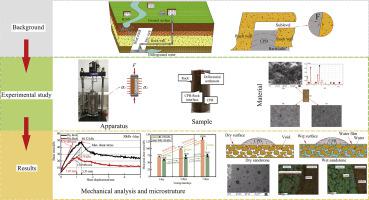Powder Technology ( IF 4.5 ) Pub Date : 2020-11-28 , DOI: 10.1016/j.powtec.2020.11.053 Zhanguo Xiu , Shuhong Wang , Yingchun Ji , Feili Wang , Fengyu Ren , Van-Tuan Nguyen

|
Cemented Paste Backfill (CPB) technology has been effective in using the tailings to refill the underground cavities. The wet or dry rock surface can significantly affect the stability of the CPB-Rock interface, and the shear load-bearing capacity of CPB-Rock interface always reflects the overall stability of the filled underground cavities. Therefore, clear understanding on the shear behavior of the CPB-Rock interface with wet or dry rock surface is very important. To investigate the shear behavior of CPB-Rock interface with different rock surfaces (wet and dry), an apparatus for shear tests at CPB-Rock interface was constructed by modifying the servo-controlled GCTS (Geotechnical Consulting & Testing System) loading frame. Over 72 CPB-Rock samples with dry and wet rock surfaces were tested under four confining pressures (0, 50, 100 and 150 kPa) and different curing time (1, 3, 7 days). The findings show that, under the same confining pressure and curing time, the shear strength of the CPB-Rock interface with the dry rock surface is much larger than that of the wet one. Furthermore, with the increase of the curing time under a same confining pressure, the increase of shear strength on the dry rock surface is also larger than that of the wet one due to the presence of water film on the wet rock surface. The shear strength is enhanced with the increase of confining pressure. Further, the testing results were analyzed within the framework of the Mohr-Coulomb criterion, which comply with the corresponding theoretical curve. It is concluded that the dry rock surface is essential to the stability of the filled underground cavities. In case of wet environment for the underground cavities, it is important to find ways to dry the rock surface before carrying out back filling using CPB method.
中文翻译:

干,湿岩石表面对岩石与水泥浆回填之间界面剪切特性的影响
水泥浆回填(CPB)技术在使用尾矿重新填充地下洞洞方面非常有效。湿的或干的岩石表面会严重影响CPB-Rock界面的稳定性,CPB-Rock界面的剪切承载力始终反映出已填充地下空腔的整体稳定性。因此,清楚了解CPB-Rock界面在湿或干岩石表面的剪切行为非常重要。为了研究CPB-Rock界面在不同岩石表面(干湿)下的剪切行为,通过修改伺服控制的GCTS(岩土工程咨询与测试系统)加载框架,构造了CPB-Rock界面的剪切测试装置。在四种围压下(0、50,100和150 kPa)和不同的固化时间(1、3、7天)。研究结果表明,在相同的围压和固化时间下,CPB-Rock与干岩石表面的剪切强度远大于湿岩石表面的剪切强度。此外,随着在相同围压下固化时间的增加,由于在湿岩石表面上存在水膜,因此干岩石表面上的剪切强度的增加也比湿岩石表面上的剪切强度的增加大。抗剪强度随着围压的增加而增强。此外,在符合相应理论曲线的Mohr-Coulomb准则框架内分析了测试结果。结论是,干岩石表面对于填充的地下空腔的稳定性至关重要。











































 京公网安备 11010802027423号
京公网安备 11010802027423号